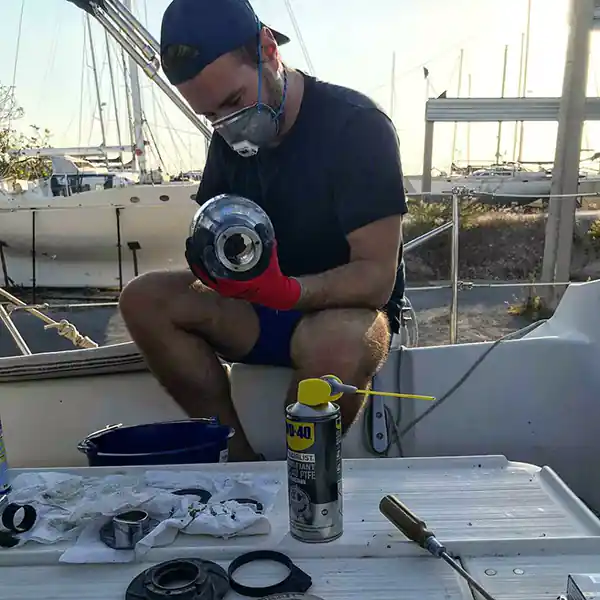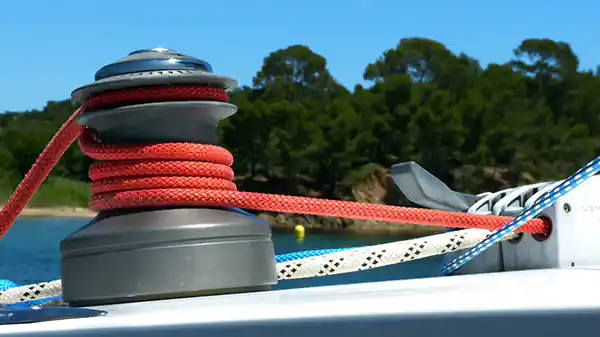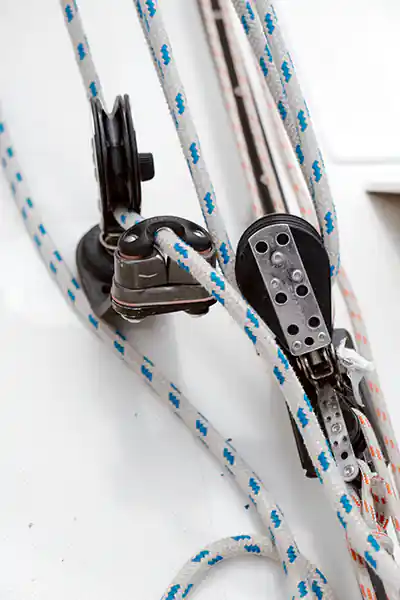How to care for your deck hardware?
Salt is just about the worst enemy of your boat.
Do you want to keep your hardware for as long as possible, but it’s deteriorating because of salt? The first thing to do is rinse your fittings more regularly. But your equipment still needs a little more attention than that.
With the help of our guide, you’ll be able to care for most type of hardware: your winches, reefing-furling systems, blocks, travellers, cleats and clutches. Proper maintenance will not only help them to last over time, but also prevent any nasty surprises on the water. Poorly maintained fittings can malfunction. And it always happens at the wrong time. What’s more, when racing, functional hardware is essential for successful manoeuvres.
So let’s start off right away. We’ll make sure to get your winches serviced properly!

Servicing your winches
A badly maintained winch can cause problems. It could jam or, on the contrary, spin freely! That’s why it’s a good idea to look after your winches once a year, for example before the new season. To take care of your winch, you’ll need to dismantle it. Take care to be methodical so that you can reassemble your winch exactly the same way. If in doubt, take pictures of each step!
White spirit will help you clean it by dissolving all the grease residue. Once everything is clean, you can check the condition of the parts. Check that the gear teeth are not bent. Make sure that the pawls and springs are also intact. If not, change them: most brands sell replacement kits.

Once your inspection is complete, you can lubricate certain parts of the winch: the gears, bearings and pawls. Finally, you can reassemble your winch, making sure that every part is in the right place. One last check to make sure everything is working properly: in one direction the winch should lock without any slack, and in the other direction it should be possible to ‘launch’ it by hand and it should continue spinning a few turns before stopping. If it doesn’t rotate on its own, it’s because it hasn’t been cleaned well enough!
Good to know: nowadays, some recent winches don’t require lubrication because they run dry. To service these, we recommend you follow the manufacturer’s recommendations.
Maintaining your reefing-furling systems
Let’s move on to the furlers now fitted on many sailing yachts. If not properly maintained, you risk damaging them. A furler in poor condition will become harder when furling your sail. This may force you to use excessive force, which can damage the furler. If your furler jams at the swivel (at the head), the halyard can go around the luff extrusion and twist it. It is therefore important to clean and lubricate your sailboat’s furling system to ensure that it works properly.
You can regularly rinse your furler’s bearings with fresh water to prevent the salt crystallising, corroding and becoming more complicated to remove later on. In particular, rinse the drum generously, as it is the most exposed. Finally, be sure to clean the foil section.
Depending on your model, you may need to lubricate a few components: the drum bearings and the swivel bearings. Use the type of lubricant (grease or oil) recommended by the manufacturer.

Also check from time to time that the screws are not loose, that there are no signs of wear on the components and that the foil is not compressed in the drum.
Finally, remember to slacken your halyards when you’re in port. It’s good for your sails, since they won’t remain under tension. But it’s also important for the smooth running of your furler: it prevents the bearings from remaining under load at rest.
Maintaining blocks and travellers
Blocks and travellers are essential for trimming your sails. If they are poorly cared for, you may find it difficult to trim the sails. So it’s important to look after the blocks on your sailboat. Similarly, you need to ensure that your mainsail luff cars, foresail and mainsheet travellers and are in good working condition.
Here again, start by rinsing regularly with fresh water or a little soap. The build-up of salt and dirt can damage your blocks. This can lead to wear and even deformation of the ball bearings.
Also, make sure that the blocks are properly aligned with the direction of the load, to avoid premature damage and wear to the blocks and carriage, or even breakage of the blocks.
Try to visually check your blocks and travellers before each departure and carry out a complete service before each season or when you install a new set of sails.
We recommend that you follow the manufacturer’s recommendations for any annual lubrication.

Caring for your cleats and clutches
The risk with poorly maintained cleats and jammers is that they release some slack, which can reduce your yacht’s performance. In the worst case, a cleat could even release under tension, but fortunately this is rarer. You can regularly rinse them in clean water to remove the salt that can damage them.
Regular washing with a non-aggressive detergent is recommended. Then, if there is a malfunction, you can dismantle the clutch or cleat in question to replace the damaged springs. It may be a good idea to lightly lubricate the mechanism. But make sure you don’t get any oily substances on the clamps, otherwise you won’t be able to jam your ropes!
A final test: make sure that the clamps, springs and handles are working properly, to ensure that your equipment is operational.
Grab your sponges!
You now know how to rinse and check your hardware regularly to ensure they’re working properly. Your winches need the most attention, so take them apart to clean and lubricate them. This will allow you to check their condition and replace any worn or broken parts. Next, make sure that your furling systems are clean and lubricated, that your blocks and travellers are free from salt build-up, and that the springs in your cleats and blocks are still effective. Now that you’ve got your deck fittings in perfect condition, your boat will be shipshape!
Your deck hardware in good condition, good. But do birds regularly come aboard? If your windvane is taking a toll from these unwanted visitors, we’ve experienced the same problem and shared our feedback: why not install an unbreakable stainless steel windvane?
